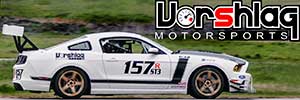cloud9
Gary
http://mustangsdaily.com/blog/2011/03/02/road-test-2012-ford-mustang-boss-302/
A couple things jumped out at me:
"More evidence of Ford’s devotion to the Boss is under the hood. Mike Harrisson, the Boss’ engine program manager, told us that the goal for the engine was 440 horsepower. As we’ve seen from the various performance shops around the country, this is a fairly easy achievement. Ford could have put on a cold air intake, added a calibration for 91 octane and called it a day. But they didn’t. The original Boss 302 was known for its high-revving V8, and Ford set about creating a true modern version of the legendary 5.0-liter engine. Nearly every component inside the engine has been replaced – cylinder heads, valves, valve springs, camshafts, pistons, connecting rods, bearings, crankshaft - with more stout parts that could handle the high RPMs. Most notably is the new intake manifold design that features shorter runners for improved air flow at high RPMs. The redline for the engine is set at 7500 rpm, but Harrisson told us it’s good up to 8400 rpm."
If that's the case, the after-market will unlock a lot more out of this motor just by revving it higher.
"We were also able to grab a Boss 302 with the Laguna Seca for a couple of laps, and while we came away impressed, we were left with a feeling that more could have been done to the car. Ford says the Laguna Seca will do a lap at its namesake track a full second faster than the standard Boss 302, but we have a hunch that most of this comes from the sticker tires. Keeping the price in check was undoubtedly a priority for Ford, but there’s plenty more they could have upgraded on the suspension, and we would have liked to see some more hardcore track options like 6-piston front brakes, a roll cage and a radio and A/C delete."
This is a common theme in the reviews between the two models. It looks like the main difference in lap times is tires. The other thing I take from this is there's going to be some modding that will make an unbelievably successful car even better on the track.
A couple things jumped out at me:
"More evidence of Ford’s devotion to the Boss is under the hood. Mike Harrisson, the Boss’ engine program manager, told us that the goal for the engine was 440 horsepower. As we’ve seen from the various performance shops around the country, this is a fairly easy achievement. Ford could have put on a cold air intake, added a calibration for 91 octane and called it a day. But they didn’t. The original Boss 302 was known for its high-revving V8, and Ford set about creating a true modern version of the legendary 5.0-liter engine. Nearly every component inside the engine has been replaced – cylinder heads, valves, valve springs, camshafts, pistons, connecting rods, bearings, crankshaft - with more stout parts that could handle the high RPMs. Most notably is the new intake manifold design that features shorter runners for improved air flow at high RPMs. The redline for the engine is set at 7500 rpm, but Harrisson told us it’s good up to 8400 rpm."
If that's the case, the after-market will unlock a lot more out of this motor just by revving it higher.
"We were also able to grab a Boss 302 with the Laguna Seca for a couple of laps, and while we came away impressed, we were left with a feeling that more could have been done to the car. Ford says the Laguna Seca will do a lap at its namesake track a full second faster than the standard Boss 302, but we have a hunch that most of this comes from the sticker tires. Keeping the price in check was undoubtedly a priority for Ford, but there’s plenty more they could have upgraded on the suspension, and we would have liked to see some more hardcore track options like 6-piston front brakes, a roll cage and a radio and A/C delete."
This is a common theme in the reviews between the two models. It looks like the main difference in lap times is tires. The other thing I take from this is there's going to be some modding that will make an unbelievably successful car even better on the track.













